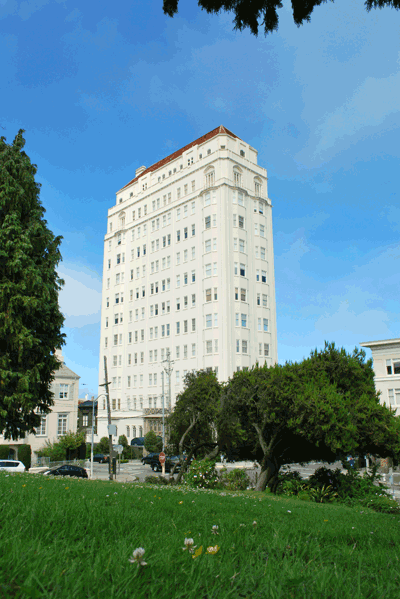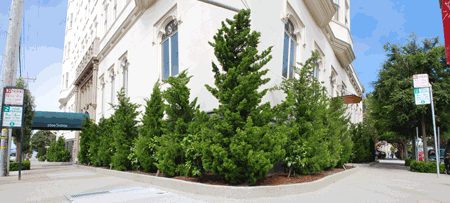
Photographs of 2500 Steiner Street by Erik Anderson
GARDENS | DEMI BOWLES LATHROP
At the crest of Steiner and Jackson Streets rises a 12 story cooperative apartment building — each floor a full flat — designed in the Mediterranean Gothic Revival style in 1927 by prominent San Francisco architect Conrad Meussdorffer. Crowned with a penthouse at the top and a maisonette with a separate entrance on the ground level, the apartments overlook their neighbor, Alta Plaza Park, and offer sweeping views in all directions.
A small garden surrounds 2500 Steiner, running north toward the bay along Steiner Street, then around the corner down Jackson. To fix the building to its site, a simple, traditional garden of small trees and evergreen shrubs was installed when the tower was built, and it remained unchanged for nearly 80 years.
Then, in 2006, star landscaper Topher Delaney — who bills herself as a creator of “dynamic physical installations” — was commissioned to design a new garden. Her creation was radically different: 19 angular steel planters ranging from 30 inches to four feet in height that marched in both directions from the corner, each carefully calibrated to compensate for the slope of the street so that every tree was planted at a uniform height.
The modern makeover became a subject of considerable discussion among the residents of 2500 Steiner. Earlier this year, they decided they’d had enough. The modern garden was removed and traditional evergreen trees that mimic the original planting returned. “It was fun while it lasted,” said Michael Lazarus, president of the building’s board of directors, “but it didn’t match the architecture of the building.”
The climate on the northeast corner of Alta Plaza Park is not ideal for a garden. A wind tunnel is formed by the building’s height and location, and fog and cool weather make streetside gardening a challenge.
Early photographs of the building show junipers of the type commonly called Hollywood junipers, for their popularity in Los Angeles gardens. Interior designer John Wheatman, who has lived longest in the building, and who has his own private garden behind his maisonette on the ground floor, says he liked the privacy the spreading junipers provided.
As the front planting matured and overgrew its planters, tree roots cracked the sidewalk. So after spearheading a renovation of the lobby, 10th floor resident Shaari Ergas turned her attention outside to the garden. Ergas has been active in restoration efforts in the Art Deco district on Miami Beach, where she spends time each year. In 2006, she brought in Topher Delaney “to do some pruning,” she says. “I’m not a landscaper,” Ergas says. “I’ve never had a garden.” When Delaney and Ergas went “crawling behind the junipers,” she says they discovered them to be so woody they were beyond pruning. “Only gnarly trunks were left, because they had grown so far forward to the light,” Ergas says. “The trees had grown so tall they had created a mask,” she says, hiding symmetrical windows flanking the front door.
Delaney has carved a dashing reputation for herself in the design world and is known for her bold, sculptural garden installations. She has said her atelier, Seam Studio, serves “as a venue for the investigation of cultural, social and artistic narratives ‘seamed’ together to form dynamic physical installations.” Her philosophy: “The ‘Promised Land’ is implicit in the everyday, not a far away place. It is here; it is now.”

The Topher Delaney garden on the Jackson Street side of the building in February 2007.
What Delaney delivered at 2500 Steiner Street was 19 angular steel planters painted the same dark color as the building’s base, each holding a twisted upright hemlock spiral underplanted with succulents. Between the phalanx of planters, reeds grew from crushed white granite. The succulents proved to be especially appealing to plant thieves and had to be replaced often, and the white granite was popular with dogs on their walk to Alta Plaza just across the street.
Part of Delaney’s installation was the streetscape. She planted four primrose trees on Steiner and two Chinese elms on Jackson. The primrose trees, evergreens native to the South Pacific and Australia, bring with them visual interest through a number of seasons. The Chinese elms, commonly known as lacebark elms, have delicate, arching branches and distinctive bark that ranges in color in mature trees from brown to cinnamon.
It was indeed a dynamic physical installation, as Delaney promised. But even as it was completed, it became clear there were mixed emotions about the results in a building of wealthy residents with strong opinions.
“The building is traditional and Topher’s work quite modern,” says Lazarus, the board president. He and his wife Laura have the seventh floor. Mark and Susie Buell, heavyweight social and political players, live in the penthouse. The ninth floor belongs to the U.S. ambassador to Hungary, Eleni Tsakopoulos Kounalakis, and her husband, Markos. And there are those who visit them: Barack Obama, Bill and Hillary Clinton and Al Gore, among others.
Of the decision to uproot the modern garden she championed, Shaari Ergas would say publicly only: “It became a politics story, which is really what’s going on here.”
“It’s a ridiculous story,” says Topher Delaney, “and has poor ramifications for the building itself — and arrogance.” She would not comment further. “As much as I’d like to participate, I can’t.”
“The results were mixed,” says Lazarus. “As a group we voted do we like it or not? Change is good. So we decided as a group to go back to the traditional.”

2500 Steiner is again surrounded by Hollywood junipers, interplanted with camellias.
The new garden, installed just months ago, was designed by the members of the board of directors. Ronen Moshe of Ronen’s Gardening was brought in to take the garden back to its traditional roots. Hollywood junipers again surround the base of the building. Residents asked for white blooming camellias, and Moshe obliged with Camellia ‘Swan Lake,’ which bears snow-white blooms in a semi-double peony form, and Camellia ‘Silver Waves,’ which boasts large, silvery white blooms with prominent yellow stamens. Camellias typically bloom in the winter, when little else in the garden does, and their glossy green leaves contrast with the other plantings.
“The residents wanted something green, with contrast in color, leaf structure and bloom,” John Wheatman says.
Not everything from the Topher Delaney planting has been removed. The primrose and Chinese elm trees on the curbs still stand. Wheatman notes, “The trees on the Steiner Street side are different from Jackson Street, different shapes, different attitudes.”
Much like the residents of the building themselves.
Demi Bowles Lathrop, a neighborhood resident, is a certified master gardener who writes frequently about plants and gardening. She is co-author of the book, Where On Earth: A Guide to Specialty Nurseries and Other Resources for California Gardeners.
Filed under: Home & Garden, Landmarks




